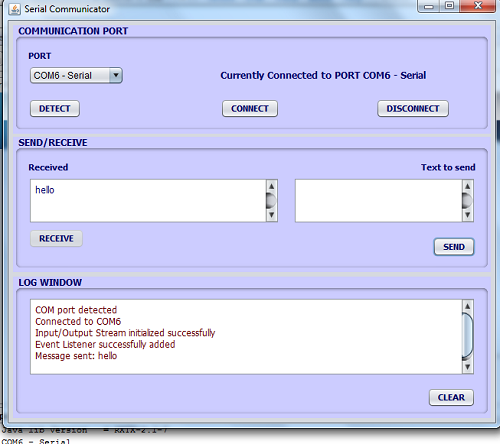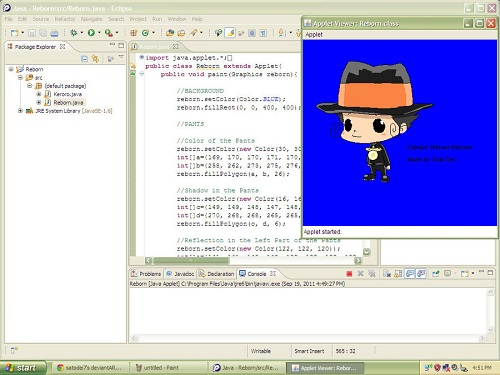Difference between Application and Applet
All Java programs are classified as Applications and Applets. While applications are stand-alone Java programs that run directly on your machine, applets are specific programs that require use of a browser and should be included in an HTML web document.
In simple terms, application programs run with the help of a virtual machine independent of any security restrictions, whereas an applet cannot run without the help of a browser and is subjected to more harsh security restrictions in terms of network access. You can say, applets are kind of an internet application that doesn’t require any kind of deployment procedure or installation. Let’s study the difference between the two in detail.
What is an Application?
It is a stand-alone Java program that runs with the support of a virtual machine in a client or server side. Also referred to as an application program, a Java application is designed to perform a specific function to run on any Java-compatible virtual machine regardless of the computer architecture. An application is either executed for the user or for some other application program. Examples of Java applications include database programs, development tools, word processors, text and image editing programs, spreadsheets, web browsers etc.
Java applications can run with or without graphical user interface (GUI). It’s a broad term used to define any kind of program in Java, but limited to the programs installed on your machine. Any application program can access any data or information or any resources available on the system without any security restrictions. Java application programs run by starting the Java interpreter from the command prompt and are compiled using the javac command and run using the java command. Every application program generally stays on the machine on which they are deployed. It has a single start point which has a main() method.
What is an Applet?
Unlike a Java application program, an applet is specifically designed to be executed within an HTML web document using an external API. They are basically small programs – more like the web version of an application – that require a Java plugin to run on client browser. They run on the client side and are generally used for internet computing. You can execute a Java applet in a HTML page exactly as you would include an image in a web page. When you see a HTML page with an applet in a Java-enabled web browser, the applet code gets transferred to the system and is finally run by the Java-enabled virtual machine on the browser.
Applets are also compiled using the javac command but can only run using the appletviewer command or with a browser. A Java applet is capable of performing all kinds of operations such as play sounds, display graphics, perform arithmetic operations, create animated graphics, etc. You can integrate an applet into a web page either locally or remotely. You can either create your own applets locally or develop them externally. When stored on a local system, it’s called a local applet. The ones which are stored on a remote location and are developed externally are called remote applets.
Browsers come with Java Runtime environment (JRE) to execute applets and these browsers are called Java-enabled browsers. The web page contains tags which specify the name of the applet and its URL (Uniform Resource Locator) – the unique location where the applet bytecodes reside on the World Wide Web. In simple terms, URLs refer to the files on some machine or network. Unlike applications, Java applets are executed in a more restricted environment with harsh security restrictions. They cannot access the resources on the system except the browser-specific services.
Difference between Application and Applet
- Definition of Application and Applet – Applets are feature rich application programs that are specifically designed to be executed within an HTML web document to execute small tasks or just part of it. Java applications, on the other hand, are stand-alone programs that are designed to run on a stand-alone machine without having to use a browser.
- Execution of Application and Applet– Applications require main method() to execute the code from the command line, whereas an applet does not require main method() for execution. An applet requires an HTML file before its execution. The browser, in fact, requires a Java plugin to run an applet.
- Compilation of Application and Applet–Application programs are compiled using the “javac” command and further executed using the java command. Applet programs, on the other hand, are also compiled using the “javac” command but are executed either by using the “appletviewer” command or using the web browser.
- Security Access of Application and Applet – Java application programs can access all the resources of the system including data and information on that system, whereas applets cannot access or modify any resources on the system except only the browser specific services.
- Restrictions of Application and Applet – Unlike applications, applet programs cannot be run independently, thus require highest level of security. However, they do not require any specific deployment procedure during execution. Java applications, on the other hand, run independently and do not require any security as they are trusted.
Application vs. Applet : Comparison Table
| Application | Applet |
| Applications are stand-alone programs that can be run independently without having to use a web browser. | Applets are small Java programs that are designed to be included in a HTML web document. They require a Java-enabled browser for execution. |
| Java applications have full access to local file system and network. | Applets have no disk and network access. |
| It requires a main method() for its execution. | It does not require a main method() for its execution. |
| Applications can run programs from the local system. | Applets cannot run programs from the local machine. |
| An application program is used to perform some task directly for the user. | An applet program is used to perform small tasks or part of it. |
| It can access all kinds of resources available on the system. | It can only access the browser specific services. |
Summary points on Application vs. Applet
The fundamental difference between the two Java programs is that an application program is designed to run on a stand-alone machine whereas an applet is a web-version of an application which is used to run a program on a web browser. While an application can access all the resources available on the system, an applet cannot have access to anything on the machine except the browser specific services.
- Difference Between Caucus and Primary - June 18, 2024
- Difference Between PPO and POS - May 30, 2024
- Difference Between RFID and NFC - May 28, 2024
Search DifferenceBetween.net :
Leave a Response
References :
[0]Boese. An Introduction to Programming with Java Applets (3rd ed.). Burlington, Jones & Bartlett Learning, 2009. Print
[1]Bishop, Owen. Getting Started With Java Applets. London, Bernard Babani Publishing, 2006. Print
[2]Eckel. Thinking in Java. Delhi, Pearson Education India, 2006. Print
[3]"Image Credit: https://stackoverflow.com/questions/19132309/error-in-preparing-standalone-java-application-with-external-libraries"
[4]"Image Credit: https://satodei7.deviantart.com/art/Java-Applet-KHR-259173241"


